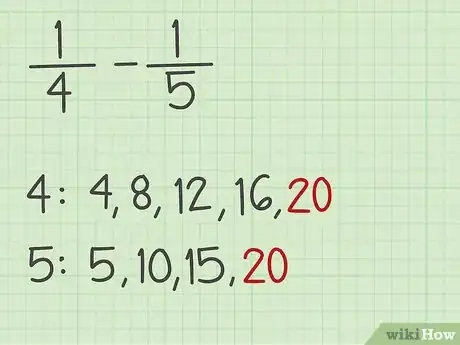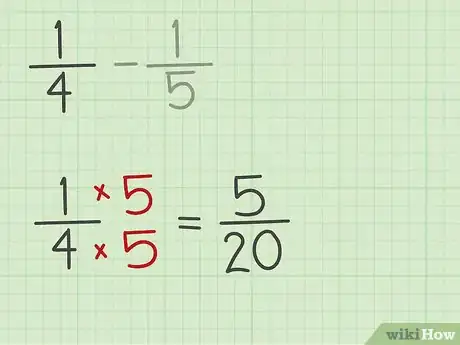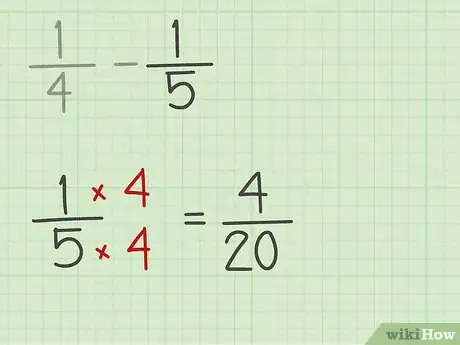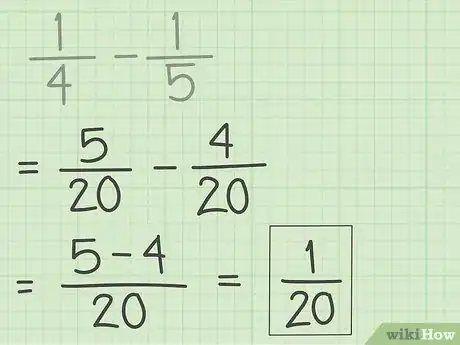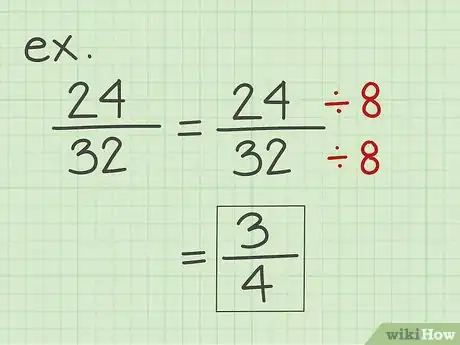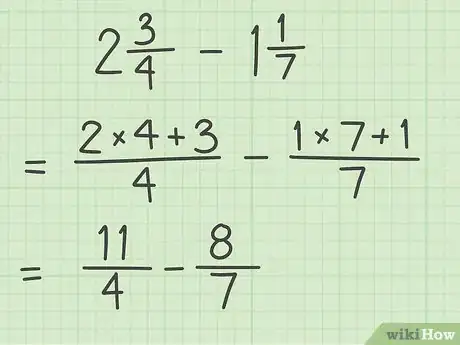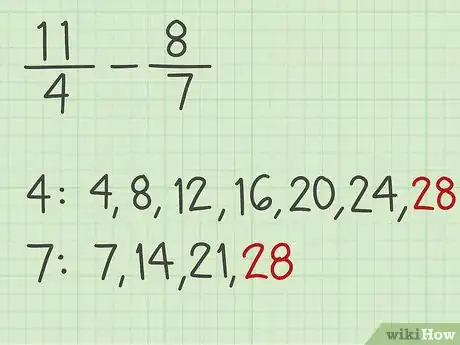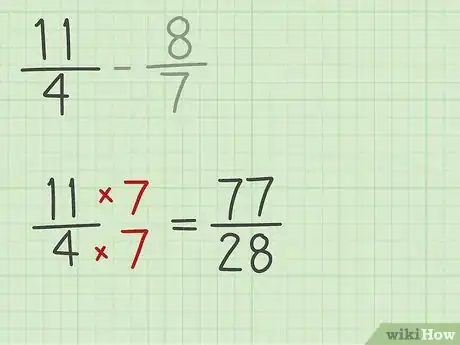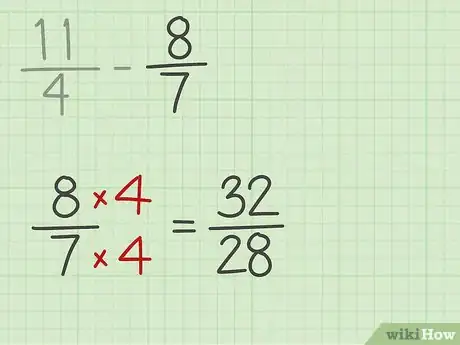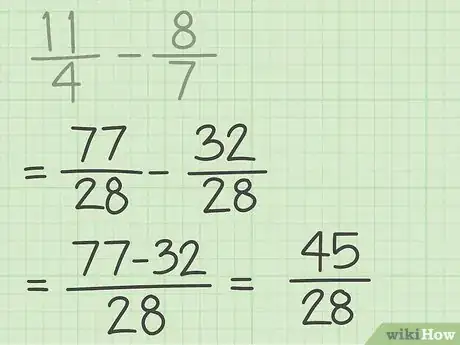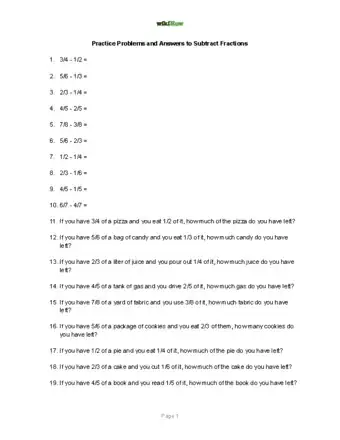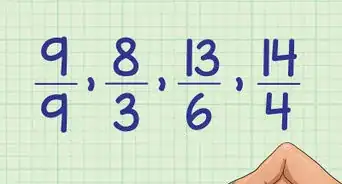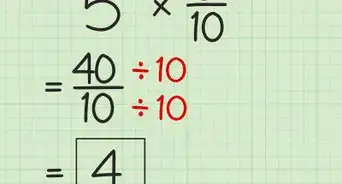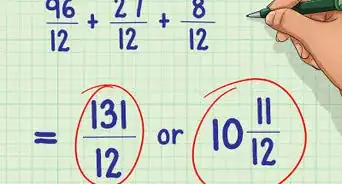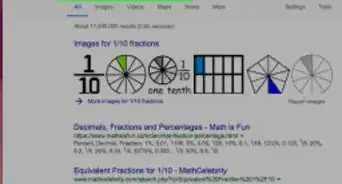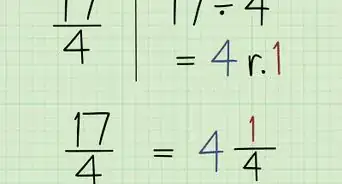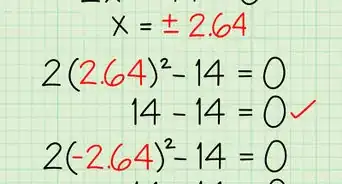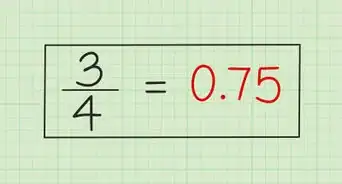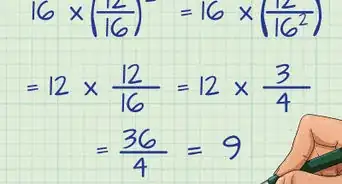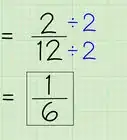This article was co-authored by David Jia and by wikiHow staff writer, Jessica Gibson. David Jia is an Academic Tutor and the Founder of LA Math Tutoring, a private tutoring company based in Los Angeles, California. With over 10 years of teaching experience, David works with students of all ages and grades in various subjects, as well as college admissions counseling and test preparation for the SAT, ACT, ISEE, and more. After attaining a perfect 800 math score and a 690 English score on the SAT, David was awarded the Dickinson Scholarship from the University of Miami, where he graduated with a Bachelor’s degree in Business Administration. Additionally, David has worked as an instructor for online videos for textbook companies such as Larson Texts, Big Ideas Learning, and Big Ideas Math.
This article has been viewed 603,002 times.
Subtracting fractions may look a little confusing at first but with some basic multiplication and division, you'll be ready for simple subtraction. If the fractions are proper, ensure that the denominators are the same before you subtract the numerators. If the fractions are mixed and you have whole numbers, turn them into improper fractions. You'll also need to make sure the denominators are the same before subtracting the numerators.
Steps
Finding the Least Common Multiple and Subtracting
-
1List multiples of the denominators if necessary. If the denominators of your fractions aren't the same, you'll need to make them the same. List the multiples of each denominator so you can find a number that both denominators have in common. For example, if you're doing 1/4 - 1/5, list all the multiples of 4 and 5 to find 20.[1]
- Since the multiples of 4 include 4, 8, 12, 16, 20 and the multiples of 5 include 5, 10, 15, and 20, 20 is the lowest number they have in common.
- If the denominators are already the same, you can skip straight to subtracting the numerators.
-
2Multiply both the numerator and denominator to get like denominators. Once you've found the lowest common multiple for your unlike fractions, multiply the fraction so the denominator becomes the least common multiple.[2]
- For example, multiply 1/4 by 5 to get a denominator of 20. You'll also need to multiply the numerator by 5, so 1/4 becomes 5/20.
Advertisement -
3Make equivalent fractions for all of the fractions in the equation. Keep in mind that if you adjust 1 of the fractions in the problem, you'll need to adjust all of the fractions so they're equivalent.[3]
- For example, if you've adjusted 1/4 to become 5/20, multiply the 1/5 by 4 to get 4/20. The original problem 1/4 - 1/5 becomes 5/20 - 4/20.
-
4Subtract the numerators and keep the denominator the same. If you started with denominators that were the same or you made equivalent fractions with the same denominator, subtract the numerators. Write the answer and then write the denominator underneath it.[4]
- Remember not to subtract the denominators as well.
- For example, 5/20 - 4/20 = 1/20.
-
5Simplify your answer. Once you have your answer, check to see if you can simplify it. Find the greatest common factor of the numerator and denominator and divide both numbers by it. For example, if you had an answer of 24/32, the greatest common factor is 8. Divide both numbers by 8 to get 3/4.[5]
- Depending on your answer, you may not be able to simplify it. For example, 1/20 can't be reduced further.
Subtracting Mixed Numbers
-
1Change the mixed numbers into improper fractions. Mixed numbers are whole numbers with fractions. To make it easier to subtract, turn the whole numbers into fractions. This will mean that the numerator will be larger than the denominator.[6]
- For example, 2 3/4 - 1 1/7 will become 11/4 - 8/7.
-
2Find a common denominator if necessary. Find the lowest common multiple of both denominators so you can make a like denominator for the fractions. For example, if you're doing 11/4 - 8/7, list all the multiples of 4 and 7 to find 28.[7]
- Since the multiples of 4 include 4, 8, 12, 16, 20, 24, 28 and the multiples of 7 include 7, 14, 21, and 28, 28 is the lowest number they have in common.
-
3Make equivalent fractions if you have to change the denominators. You'll need to make denominators become the lowest common multiple. To do this, multiply the entire fraction.[8]
- For example, to make the denominator for 11/4 become 28, multiply the fraction by 7. The fraction will become 77/28.
-
4Adjust all of the fractions in the problem to make them equivalent. If you've changed the denominator for 1 of the fractions in your problem, you'll need to adjust the other fractions so their ratios are still equal to the original problem.[9]
- For example, if you've adjusted 11/4 to become 77/28, multiply the 8/7 by 4 to get 32/28. The problem 11/4 - 8/7 becomes 77/28 - 32/28.
-
5Subtract the numerators and keep the denominator the same. If the denominators were the same to begin with or you've made equivalent fractions, you can now subtract the numerators. Write the answer and place it over the denominator. Remember not to subtract the denominator.[10]
- For example, 77/28 - 32/28 = 45/28.
-
6Simplify the answer. You'll probably need to change the answer into a mixed number. Start by dividing the numerator by the denominator to get a whole number. Then write how many parts you have left. This number will be the numerator. Place the numerator over the same denominator.Reduce this fraction if you can.[11]
- For example, 45/28 becomes 1 17/28 because 28 goes into 45 1 time and has 17 parts of 28 left over.
Practice Problems and Answers
Community Q&A
-
QuestionHow do I subtract a fraction from a whole number?
 Community AnswerTake the LCM of denominator of both the fractions (the denominator of whole number is one). Then, in both the numbers divide the LCM by the denominator and multiply the result by the numerator. Subtract the numbers in numerators and you will get your answer.
Community AnswerTake the LCM of denominator of both the fractions (the denominator of whole number is one). Then, in both the numbers divide the LCM by the denominator and multiply the result by the numerator. Subtract the numbers in numerators and you will get your answer. -
QuestionCan you help me solve 1/4 - 5/6 please?
 Community Answer1/4 - 5/6 = -7/12. That is a negative number.
Community Answer1/4 - 5/6 = -7/12. That is a negative number. -
QuestionHow can I learn to subtract a mixed fractions?
 JulyAtNightCommunity AnswerTurn them into improper fractions. Then you can make the denominator the same to subtract them. Don't forget to simplify if necessary.
JulyAtNightCommunity AnswerTurn them into improper fractions. Then you can make the denominator the same to subtract them. Don't forget to simplify if necessary.
References
- ↑ https://www.georgebrown.ca/uploadedFiles/TLC/_documents/Adding%20and%20Subtracting%20Proper%20Fractions.pdf
- ↑ https://www.georgebrown.ca/uploadedFiles/TLC/_documents/Adding%20and%20Subtracting%20Proper%20Fractions.pdf
- ↑ https://www.mathsisfun.com/fractions_subtraction.html
- ↑ https://www.mathsisfun.com/fractions_subtraction.html
- ↑ https://www.georgebrown.ca/uploadedFiles/TLC/_documents/Adding%20and%20Subtracting%20Proper%20Fractions.pdf
- ↑ https://www.mathsisfun.com/numbers/fractions-mixed-addition.html
- ↑ https://www.mathsisfun.com/numbers/fractions-mixed-addition.html
- ↑ https://www.mathsisfun.com/equivalent_fractions.html
- ↑ https://www.georgebrown.ca/uploadedFiles/TLC/_documents/Adding%20and%20Subtracting%20Mixed%20Numbers%20and%20Improper%20Fractions.pdf
About This Article
To subtract fractions, first make sure the denominators are the same. If they're not, find the least common multiple of the 2 denominators. Then, multiply each denominator so that it equals the least common multiple. Next, multiply the numerator by the same number you multiplied the denominator by. Finally, subtract the numerators and leave the denominator as the least common multiple. To learn how to subtract mixed numbers, scroll down!
